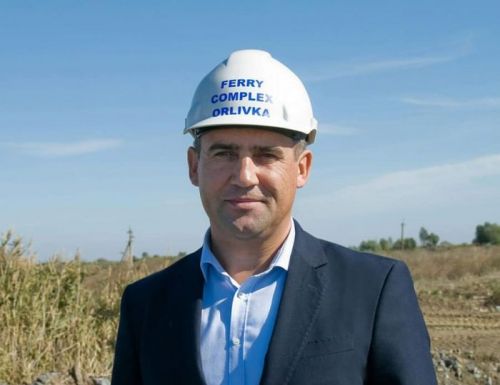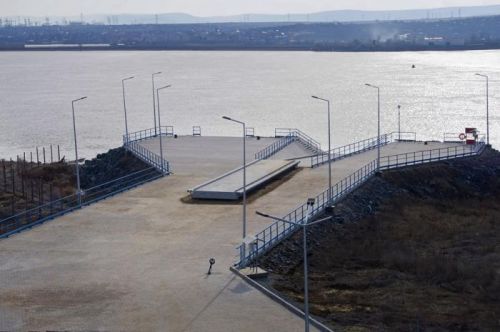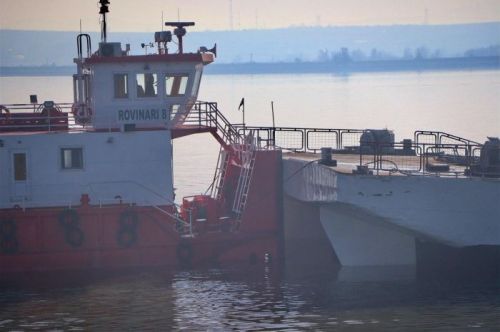The need to launch a ferry service on River Danube in the southern part of Ukraine was first discussed in the 1990s, when the first protocol of intent between the Odesa region and the Romanian side was signed. However, the period from the signing of the protocols to the practical implementation of the project was about 25 years (construction began only in 2015). The original plan was that the ferry crossing would be ready by the summer of 2016, but work on the Ukrainian side was completed only at the beginning of 2019. The date of commissioning of the ferry crossing was postponed repeatedly after that, largely due to bureaucratic delays on the Romanian side. Nevertheless, the ferry performed its first two test trips in September last year. Romania completed its part of the ferry crossing in July this year and the ferry crossing was launched into operation on August 10.
In an exclusive interview with the CFTS portal, the Odesa regional council’s Deputy Chairman Yurii Dimchohlo, who was one of the initiators of the ferry project, discusses how much it will cost to travel the distance of 900 meters between Orlivka and the Romanian city of Isaccea on a ferry across River Danube, the advantages of the project, and when investors can expect to recoup the money they invested in the project.
Tell us about the history of the project.
We have 167 kilometers of River Danube but not a single checkpoint. In southern Ukraine, all roads lead through Moldova. Orlivka-Isaccea is practically the only place on River Danube through which the E87 international route passes, and trucks can drive up to the bank of River Danube from both Ukraine and Romania without hindrance.
The issue of building the Orlivka-Isaccea ferry crossing was first discussed in 1994, when the first protocol of intent was signed between the Odesa region and the Romanian side. Some protocols were signed every few years after that.
I presented the project at the end of 2013. A pre-feasibility study was prepared and a detailed layout of the territory was approved. The feasibility study for the project was presented to the regional administration in 2014, and we were granted a 49-year lease on the site for construction of the facility in February 2015.
Simultaneously, the regional administration and we jointly initiated the signing of an intergovernmental agreement on the opening of the Orlivka-Isaccea border crossing, which was also signed in 2015.
When did construction begin?
We started construction work in 2015 and finished it at the end of 2018. We test-operated the ferry twice in 2019 and launched the ferry into operation on 10 August 2020.
What was built?
As of today, the border crossing itself has been built, and it consists of several buildings: an administrative building, a quarantine room, dog enclosures, a waiting room, a building for in-depth inspection of vehicles, commercial premises, control cameras, sanitary zones, etc., as well as a two-level hydraulic structure that is designed for the low and high levels of River Danube.
What is the estimated cost of the project?
The design documentation alone cost USD 200,000. In total, investors spent EUR 5-5.5 million on the project.
What is the payback period for the project?
Between 6.5 and 8 years.
Who are the investors?
I was one of the investors before I became the deputy head of the regional council. I later transferred my share to my wife. In addition to me, there are two investors: the Ukrainian company Tigos (founded by Odesa regional councilor Oleg Sulakov – CFTS) and a British company with Ukrainian roots. The investors own equal shares in the project.
Are the investments on the Romanian side also private?
Yes. The Romanian company Navrom Bac was granted a 20-year concession on part of the Isaccea port for the purpose of construction of the ferry crossing. The company also owns several other crossings on River Danube. The cost of the project on their side is estimated at about EUR 5 million. These funds were used to build the border crossing, hydraulic structures, and a ferry. This project was fully financed by investors on the Ukrainian side, but the European Union will compensate the EUR 1.1 million that was spent on construction of the border crossing on the Romanian side.
You received permission to commission the facility in 2019, why is it only just beginning operation?
Romania delayed the project last year. We lost six months because the European Union subsidized their project, which means that the European Union monitored every stage of the project, as well as because of the coronavirus. We were preparing to launch it at the end of March.
This project was earlier described as one of the first examples of public-private partnership...
The Ministry of Economic Development wanted to register it as the first public-private project in Ukraine in 2018, when the law on public-private partnership was being prepared. However, they abandoned the idea because construction permits were issued back in 2015.
What are the advantages of the ferry crossing?
Firstly, a direct link with southern Europe and a shorter route to Romania and Turkey. Secondly, there will be no need to pay transit fees in Moldova, which amount to EUR 4 from per car and EUR 25-35 per truck, and there will be no need for transit declarations. In total, trucks pay about EUR 60 when passing through Moldova. Thirdly, the period of customs control will be reduced. Currently, drivers need to go through four border controls – one Ukrainian, two Moldovan, and one Romanian – to get to the ports of Romania or Turkey. Moreover, each truck spends between 12 hours and two days being processed. A vehicle using the ferry crossing needs to go through only two customs controls – Ukrainian and Romanian – which takes 2 to 4 hours. This is a big boost for transport companies.
What is the economic benefit for the region?
The accompanying infrastructure – filling stations, cafes, and markets – will develop in the Orlivka area. In addition, we are counting on an influx of tourists. Isaccea is located one and a half hour from the large city of Constanta. A tourist information center will be opened in the ferry complex next March, which will also give an impetus to development of tourism.
How many ferries will operate?
We are starting with one ferry. The Romanian company Navrom built it specifically for this project. It costs EUR 480,000. It has a draft of 140 centimeters, and it is capable of carrying 15 trucks. There is also the possibility of ferrying cars and people. As soon as we see that one ferry is no longer sufficient, the Ukrainian side is obliged to build a similar one. Then we can have a timetable of one ferry every half hour.
What will be the ferry’s operating frequency and operating hours?
One ferry will give us a frequency of one trip per hour. We have permission from the Ukrainian and Romanian authorities to operate around the clock. However, Romania has not yet lifted the state of emergency it declared because of the coronavirus. Therefore, only trucks are currently allowed to be ferried. The possibility of opening the ferry to passenger cars will be considered in the next two weeks. For this reason, the crossing will operate from 8 am to 8 pm for now.
What are the ferry fees?
EUR 1 per passenger, EUR 2 per motorcycle or moped, EUR 15 per passenger car, EUR 25 per minibus, EUR 35 per small truck, and EUR 50 per truck.
What volume of traffic are you expecting?
We expect at least 50-70 vans and 120-150 light vehicles per day although the actual capacity of the ferry is several times greater.





